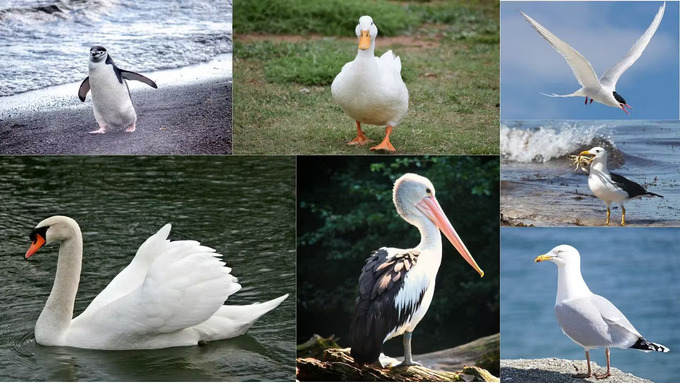Many birds gracefully soar through the skies, but did you know some species possess the unique ability to swim underwater? If you’ve ever wondered about birds that excel both in the air and water, you’re in for a treat.
From ducks and geese to swans and pelicans, several bird species masterfully combine these dual talents. Let’s dive deeper into their fascinating world and explore their adaptations, behaviors, and habitats.

Ducks are exceptional swimmers and skilled fliers. They navigate water with ease and take to the skies for migration or to evade predators. Well-known species include mallards, wood ducks, teals, pintails, and mergansers. Their webbed feet, streamlined bodies, and water-resistant feathers make them proficient swimmers and divers.
Geese are highly capable both on water and in the air. They spend much of their time in aquatic environments and migrate vast distances in distinctive V-shaped formations. Their strong wings, webbed feet, and waterproof plumage enable them to thrive in both realms.
Majestic and powerful, swans are masters of the water but also fly impressively during migration. Species like mute, trumpeter, and whooper swans use their long wings and streamlined bodies to generate lift and navigate wetlands across continents.
Adaptable and agile, gulls and terns swim, dive, and soar effortlessly. Common along coastlines worldwide, they rely on water-resistant feathers, sharp vision, and aerodynamic profiles to catch fish and navigate marine environments.
Members of the auk family, such as puffins and murres, are strong swimmers and capable fliers. These birds dive to catch fish but can also escape predators by flying. Compact bodies, fortified bones, and short wings make them well-suited for their amphibious lifestyle.
Loons are adept divers and efficient fliers. Found in northern lakes, they migrate to warmer waters during winter. Dense bones, pointed wings, and sharp bills aid in their underwater pursuits and long-distance flights.
Resembling loons, grebes are skilled water birds that also fly competently. Found in lakes and wetlands, they dive to catch fish and crustaceans. During migration, they form flocks capable of covering vast distances.
Cormorants are excellent swimmers and migratory fliers. Found near rivers, lakes, and coastlines, they use keen eyesight and sharp beaks to snatch fish. After fishing, they often perch with outstretched wings to dry before taking flight.
Known as “snakebirds,” anhingas are tropical swimmers and fliers. With long necks and sharp bills, they spear fish underwater. Afterward, they spread their wings to dry before soaring gracefully over wetlands.
Large and powerful, pelicans excel in swimming and flying. They use their elastic throat pouches to catch fish before gliding above the waves. Their ability to combine strength and grace makes them an impressive sight.
Webbed feet help swimming birds paddle efficiently, creating thrust in water. This adaptation allows ducks, swans, and pelicans to maneuver gracefully.
Aquatic birds have oil-coated feathers that repel water, keeping them insulated and buoyant. Regular preening ensures their plumage remains water-resistant.
A sleek, aerodynamic body reduces drag in water, enhancing swimming efficiency. Penguins and loons exemplify this adaptation.
Strong pectoral muscles enable both flying and swimming. Birds like cormorants use these muscles to dive deeply and take off swiftly.
Long necks allow birds to catch fish with precision. Swans, for example, use their S-shaped necks to reach food beneath the surface.
Preen glands produce oils to waterproof feathers. Birds spread this oil meticulously, ensuring their plumage remains functional during dives.
Swimming birds use webbed feet to paddle, pushing against the water for forward motion. Ducks and geese can generate thrust while steering effortlessly.
Diving birds like loons and puffins use dense bones and streamlined shapes to submerge and chase prey. Specialized feathers and wings reduce drag underwater.
Swimming birds employ various techniques to take flight. Ducks and geese use a running start across water, while loons and swans rely on rapid wing flapping.
Birds like gulls and terns thrive along coasts, where nutrient-rich waters provide ample food. Rocky cliffs offer safe nesting sites.
Inland water bodies attract ducks, swans, and loons. These habitats offer food and nesting areas, though many wetlands face threats from human activity.
Aquatic birds often migrate vast distances to find suitable feeding and nesting grounds. Arctic terns hold the record for the longest migration, traveling over 70,000 km annually.
Birds that can both swim and fly are marvels of adaptation, seamlessly navigating air and water. From ducks paddling in ponds to puffins diving into ocean depths, these birds demonstrate the remarkable versatility shaped by evolution.
Next time you spot a bird gliding over water or diving beneath the surface, take a moment to appreciate its incredible dual talents and the natural world that supports such diversity.
animal tags:
We created this article in conjunction with AI technology, then made sure it was fact-checked and edited by a Animals Top editor.